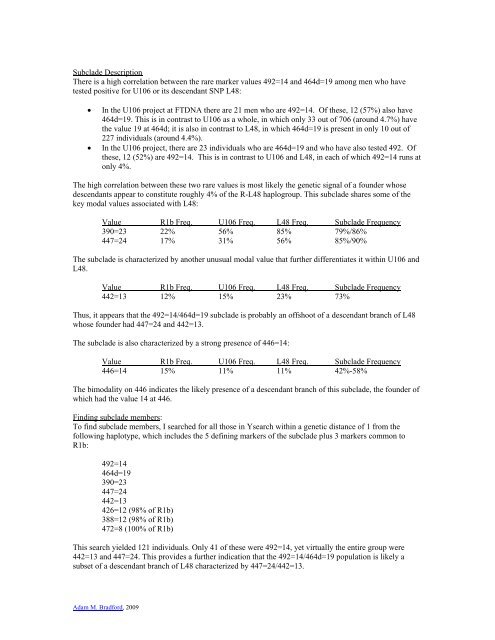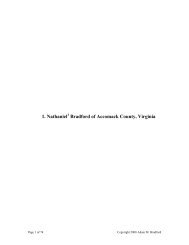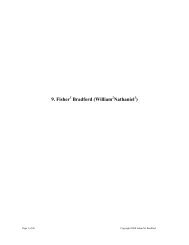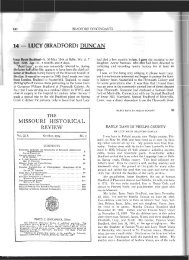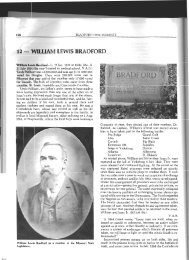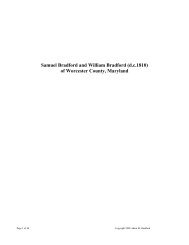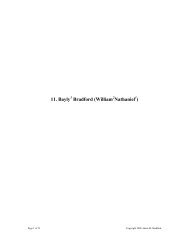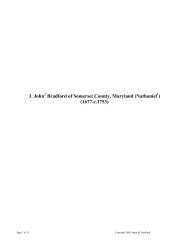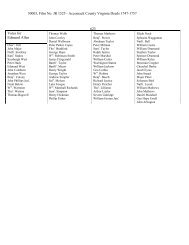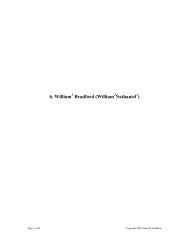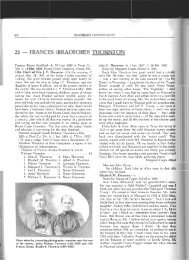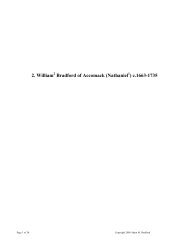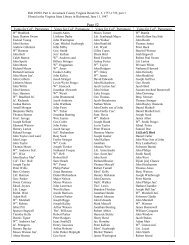Deep Ancestry - Lower Delmarva Bradfords
Deep Ancestry - Lower Delmarva Bradfords
Deep Ancestry - Lower Delmarva Bradfords
You also want an ePaper? Increase the reach of your titles
YUMPU automatically turns print PDFs into web optimized ePapers that Google loves.
Subclade Description<br />
There is a high correlation between the rare marker values 492=14 and 464d=19 among men who have<br />
tested positive for U106 or its descendant SNP L48:<br />
• In the U106 project at FTDNA there are 21 men who are 492=14. Of these, 12 (57%) also have<br />
464d=19. This is in contrast to U106 as a whole, in which only 33 out of 706 (around 4.7%) have<br />
the value 19 at 464d; it is also in contrast to L48, in which 464d=19 is present in only 10 out of<br />
227 individuals (around 4.4%).<br />
• In the U106 project, there are 23 individuals who are 464d=19 and who have also tested 492. Of<br />
these, 12 (52%) are 492=14. This is in contrast to U106 and L48, in each of which 492=14 runs at<br />
only 4%.<br />
The high correlation between these two rare values is most likely the genetic signal of a founder whose<br />
descendants appear to constitute roughly 4% of the R-L48 haplogroup. This subclade shares some of the<br />
key modal values associated with L48:<br />
Value R1b Freq. U106 Freq. L48 Freq. Subclade Frequency<br />
390=23 22% 56% 85% 79%/86%<br />
447=24 17% 31% 56% 85%/90%<br />
The subclade is characterized by another unusual modal value that further differentiates it within U106 and<br />
L48.<br />
Value R1b Freq. U106 Freq. L48 Freq. Subclade Frequency<br />
442=13 12% 15% 23% 73%<br />
Thus, it appears that the 492=14/464d=19 subclade is probably an offshoot of a descendant branch of L48<br />
whose founder had 447=24 and 442=13.<br />
The subclade is also characterized by a strong presence of 446=14:<br />
Value R1b Freq. U106 Freq. L48 Freq. Subclade Frequency<br />
446=14 15% 11% 11% 42%-58%<br />
The bimodality on 446 indicates the likely presence of a descendant branch of this subclade, the founder of<br />
which had the value 14 at 446.<br />
Finding subclade members:<br />
To find subclade members, I searched for all those in Ysearch within a genetic distance of 1 from the<br />
following haplotype, which includes the 5 defining markers of the subclade plus 3 markers common to<br />
R1b:<br />
492=14<br />
464d=19<br />
390=23<br />
447=24<br />
442=13<br />
426=12 (98% of R1b)<br />
388=12 (98% of R1b)<br />
472=8 (100% of R1b)<br />
This search yielded 121 individuals. Only 41 of these were 492=14, yet virtually the entire group were<br />
442=13 and 447=24. This provides a further indication that the 492=14/464d=19 population is likely a<br />
subset of a descendant branch of L48 characterized by 447=24/442=13.<br />
Adam M. Bradford, 2009
Age Estimates<br />
ASD calculations for the 67 marker haplotypes in this subclade using Tim Janzen’s excel utility yield age<br />
estimates ranging from 43 to 49 generations, or about 1075 to 1470 years using a generation length of 25 to<br />
30 years. Thus, the subclade progenitor may have lived roughly between 500 to 900 AD. However, this<br />
may be an underestimate, since the sample from which it was deduced does not contain those who may<br />
have experienced mutations away from the ancestral values on several of the key markers that define the<br />
subclade.<br />
Subclade Members<br />
The attached spreadsheet contains 109 individuals who may be identified as likely members of this<br />
subclade. Identification was based on having the value 14 at 492 and two out of the other three defining<br />
markers: 464d=19, 447=24, and 442=13. I also included those who are a tight match on at least 25 markers<br />
with someone of the same surname whose 67-marker results warranted their inclusion. If an individual has<br />
been SNP tested, the most downstream SNP for which they have tested positive is listed. I have also<br />
included SNP results for those who have the same surname as those who have been SNP tested and who are<br />
a close match with them.<br />
Spreadsheet of Subclade Haplotypes<br />
Sources for clade members were Ysearch and FTDNA’s U106 project, supplemented by public results from<br />
various FTDNA surname projects.<br />
Walk The Y<br />
The Middlebrook man who is a member of this clade is participating in the L48 Walk the Y project<br />
currently being undertaken with FTDNA. The L48 WTY Project is a concentrated effort to find SNPs to<br />
help further subdivide the L48 haplogroup. With the exception of the SNP L47 and its descendants L44,<br />
L45, and L46 (members of this subclade do not have the L47 SNP), the branch structure of L48 is currently<br />
only guessed at by analyzing STR results. There is a Wade man in the WTY who is not a member of the<br />
492=14/464d=19 clade, but who does have 447=24/442=13.<br />
Bimodality on 446<br />
As noted above, there is a bimodality in this group on marker 446, with a roughly even split between the<br />
values 14 and 13. 13 is likely the ancestral value, since it is the modal of L48 and its ancestor R1b clades.<br />
The following chart shows which surnames have which value. Penningtons and Ratcliffs fall on both sides.<br />
14 13<br />
Bowen<br />
Brooks<br />
Burch<br />
Griffin<br />
Haworth<br />
Holland<br />
Middlebrooks<br />
Morris<br />
Pennington<br />
Pickett<br />
Ratliff<br />
Stephenson<br />
Struthers<br />
Walker<br />
Bradford<br />
Braidwood<br />
Crumpler<br />
Dawson<br />
Delise<br />
Disbrow<br />
Holder<br />
Horrell<br />
Mitchell<br />
Pennington<br />
Pope<br />
Ratcliff<br />
Reed<br />
Reynolds<br />
Van Camp<br />
Ratliff/Radcliff-Pennington/Pinnington Match<br />
A sizeable portion of this subclade appear to be descendants of Nicholas de Radeclive of Lancashire<br />
(b.c.1097-1100). The standard genealogy claims he was a great-grandson in the direct male line of Ivo de<br />
Taillebois of Anjou, who came to England with William the Conqueror. Nicholas was apparently the son of<br />
Gilbert de Lancaster and was given the manor of Radeclive in Lancashire, after which he went by Nicholas<br />
de Radeclive, whence the surname Radcliff and variants. Nicholas’ great -grandson Hugh de Radeclive<br />
Adam M. Bradford, 2009
(b.c.1192, Lancashire) married the heiress Margery de Pininton and adopted her name (whence the surname<br />
Pennington and variants). This shared ancestry for Ratcliffs and Penningtons is borne out by the DNA<br />
evidence.<br />
A group of at least 29 Radcliff (and variants) men are members of this subclade and they are a close match<br />
with 5 men named Pennington/Pinnington. The MRCA of this branch may be narrowed down to the three<br />
generations from Nicholas de Radcliff (b.c.1097/1100), the first to adopt the name Radcliff, on down to<br />
William de Radeclive (b.1164), whose son adopted the name Pennington. The genetic distance between<br />
the Penningtons and Radcliffs (about 9 on 67 markers) is largely consistent with an MRCA in this period.<br />
The Ratliff/Pennington group all have the relatively rare 572=10, which is found in 8% of R1b and in 8%<br />
of U106. This value is shared by the Haworth/Howarth family, which also hails from Lancashire. It is also<br />
held by a man named Morris who traces his origins to Lancashire. Two men named Bowen are also<br />
572=10.<br />
It would be interesting to see if any men with the surname Lancaster turn up a match, since Nicholas de<br />
Radeclive’s older brother William went by “de Lancaster” and apparently had descendants who kept it as a<br />
family name.<br />
Five of the seven Ratcliffs who have tested 67 markers are 481=24, which could be a tag for a specific<br />
branch of Ratcliffs.<br />
Brooks<br />
There is a Brooks family in this clade that hails from Manchester, a city in south Lancashire. They do not<br />
have the 572=10 shared by the Penningtons and Ratcliffs, though they do have 446=14. This family is an<br />
extremely close match (from 0 to 4 on 67 markers) with a man named Holland whose earliest known<br />
ancestor lived in Bavaria. Brooks and Holland are distinguished by 458=15 and 442=12.<br />
The following map illustrates some of the locations in Lancashire which contained subclade members:<br />
Bradford/Braidwood Branch<br />
The <strong>Bradfords</strong> and Braidwoods clearly share a relatively recent common ancestor. They also appear to be<br />
more distantly related to the rest of the cluster due to values on certain STRs which are not present in the<br />
rest of the cluster, but which they all share. These include 390=24, 389i=12, H4=10, YCAII=22, 413b=24,<br />
and 442=14/15. The surname Braidwood is unique and appears to have once been confined to Lanarkshire,<br />
Adam M. Bradford, 2009
Scotland, where there is a town of the same name. There is evidence that at least two of the Bradford<br />
lineages are of Scots-Irish descent, so that name is likely an Anglicization of a Scottish surname, possibly<br />
Braidwood or Braidfute, which was also present in Lanarkshire. Despite being found earliest in Scotland,<br />
the Braidwood surname seems ultimately to be of Anglo-Saxon derivation.<br />
Holder-Disbrow<br />
Men of the Holder and Disbrow surnames are close matches on 37 markers and share certain rare values:<br />
389i=14<br />
458=16<br />
460=10<br />
464c=16<br />
* * *<br />
The following tree depicts a best guess as to how this clade is descended from L48 and a tentative grouping<br />
of some of the more visible subdivisions of the subclade, based on the shared mutations outlined above.<br />
Adam M. Bradford, 2009
The following network diagram of the 67 marker haplotypes was generated using Fluxus:<br />
The diagram tends to confirm certain aspects of the hypothetical descendant chart listed above. Note the<br />
presence of distinct branches for Bradford/Braidwood, Holder/Disbrow, and Brooks.<br />
Observations on Origin<br />
There are only 2 men of proven Continental ancestry in this sucblade: a Holland from Bavaria and a Van<br />
Campen from the Netherlands. Other than these 2 Continental men, the surnames in the subcluster are<br />
mostly of English or Norman derivation. Even those of Scottish descent - Braidwood/Bradford and<br />
Struthers - have Anglo-Saxon rather than Gaelic surnames. There are two Irish lines – Pickett and<br />
Stephenson/Steenson; as with the Scottish lines, the surnames suggest an Anglo-Saxon/Norman rather than<br />
Celtic/Gaelic origin.<br />
Adam M. Bradford, 2009
The earliest known locations of those who are able to trace their origins to Europe are plotted on the<br />
following map. Note the thick cluster of locations in Lancashire.<br />
Adam M. Bradford, 2009


